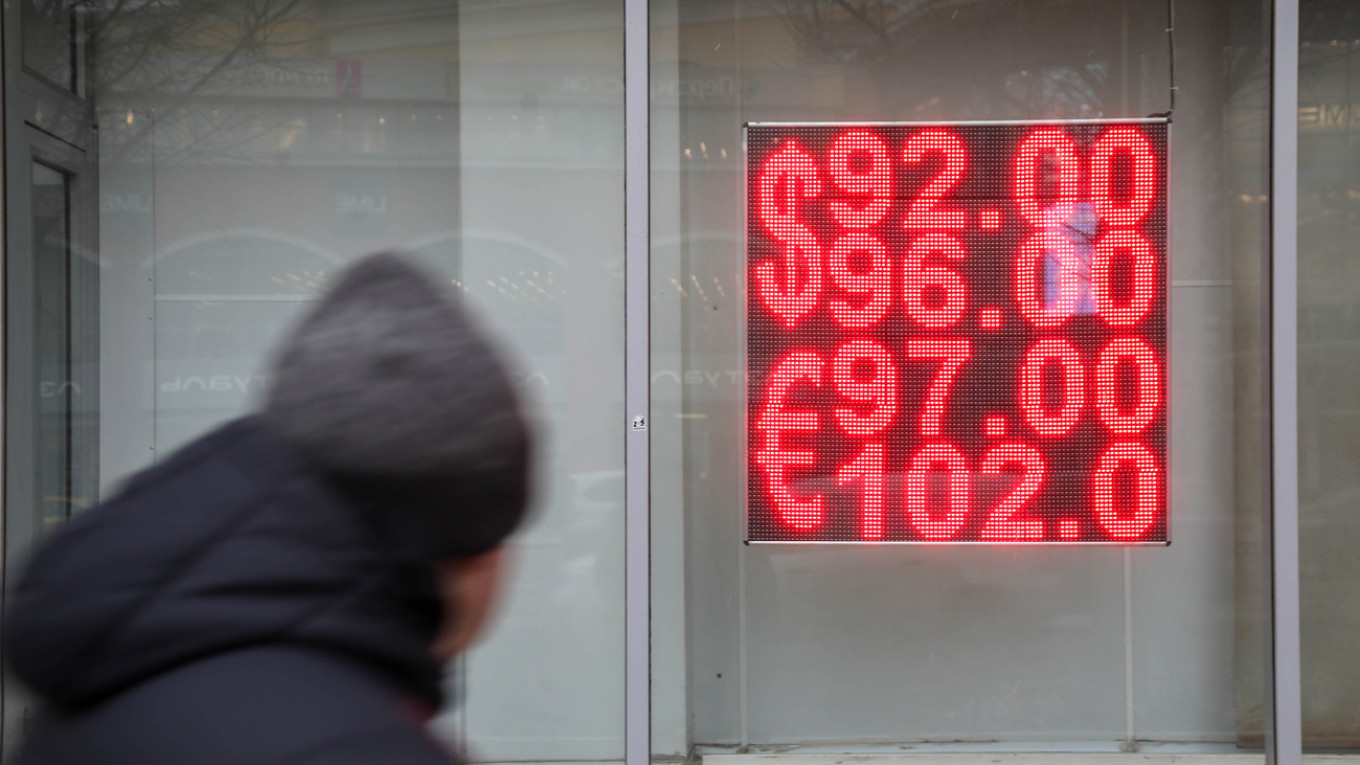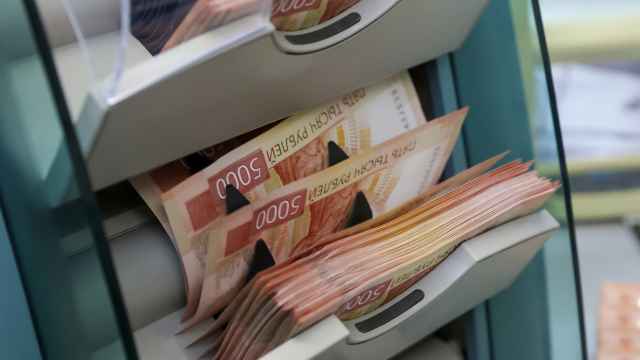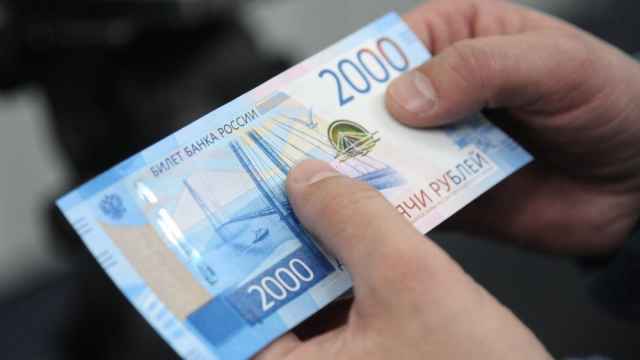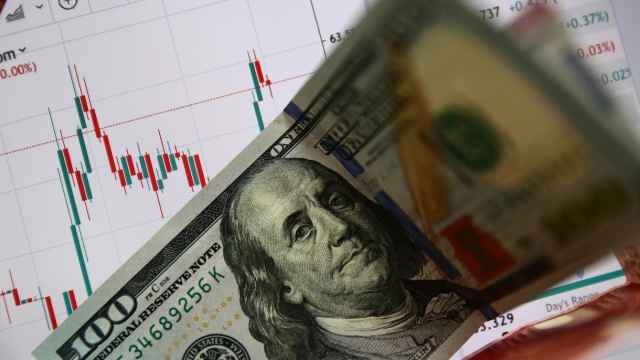After collapsing to 100 to the dollar last summer, the Russian ruble has recovered a lot of ground and has now settled at a relatively strong level of 90 to the dollar.
Further appreciation or sustained stability will require a significant reduction in geopolitical tensions and the lifting of Western sanctions on Russian oil exports, Renaissance Capital said in a note on Monday.
Current forecasts place the ruble's average exchange rate for 2025 within a broad range of 80 to 100 per U.S. dollar, depending on external conditions.
At the start of 2025, Russia’s accumulated inflation since 2021 stood at 31.8%, compared to 12.4% in developed economies, according to the International Monetary Fund. This disparity suggests that an equilibrium exchange rate — assuming a return to normal economic conditions — would be approximately 91 per U.S. dollar, up from 74 in 2021, Rencap’s analysts say.
“However, economic fundamentals alone will not dictate the ruble’s trajectory, as capital flows, trade balance constraints and geopolitical developments remain key factors,” Rencap said.
A primary constraint on ruble appreciation is the need to maintain a current account surplus, which Russia has relied on to stabilize its external position. Even if geopolitical tensions ease, a persistent capital outflow or continued domestic demand for foreign assets would limit ruble strengthening. Moreover, the Russian Central Bank is likely to continue rebuilding reserves, adding further constraints.
Rencap outlined four potential scenarios for the ruble’s exchange rate in 2025:
- Sustained geopolitical tensions: If no diplomatic progress is made, the exchange rate is expected to remain above 100 per U.S. dollar, with the current account surplus projected at 2.2% of GDP.
- Conflict freeze and partial sanctions relief: If hostilities subside and U.S. sanctions are lifted, Russian oil discounts would narrow, economic uncertainty would decline and capital outflows would be curtailed. This scenario would see the ruble stabilize at 95-96 per U.S. dollar, with a 1.4% of GDP current account surplus.
- Comprehensive sanctions relief: If restrictions on Russian oil transportation are removed by both the U.S. and the EU, oil discounts would be minimized, and trade settlements would improve. While some capital controls would persist, the ruble could strengthen to 87-88 per U.S. dollar, with a current account surplus of 0.8% of GDP.
- Peak appreciation: Under optimal conditions, an 82-83 per U.S. dollar rate could be achieved temporarily, but this would likely prove unsustainable as Russia’s trade surplus erodes.
Ceasefire talks between Russia and the U.S. kicked off in Riyadh on Feb. 18 and have gone well for Russia. Ukraine’s European allies are becoming increasingly alarmed at U.S. President Donald Trump’s increasingly pro-Russia position and echoing Kremlin talking points. Before the talks had even begun, the White House made two major concessions to the Kremlin — conceding occupied territory to Russia and no NATO membership for Ukraine.
Since then, U.S. National Security Advisor Mike Waltz has said any peace deal should be founded on the terms agreed at the failed 2022 Istanbul peace deal — another long-standing demand by Putin — and over the weekend Waltz suggested that sanctions relief could be part of the agreement.
Against this, Trump is putting extreme pressure on Ukrainian President Volodymyr Zelenskiy to sign away rights to 50% of the revenues earned on all Ukraine’s natural resources and has proposed a three-stage peace process that includes presidential elections as the second step, before a ceasefire deal is agreed, that will likely see Zelenskiy replaced as president.
Despite these projections, Rencap cautions that two major risks remain. Firstly, financial account flows could diverge from expectations due to unforeseen capital movements or potential asset unfreezing. Secondly, structural shifts in Russia’s economy — including changes in import dependence — introduce uncertainty in how domestic demand affects the balance of payments.
“Ultimately, the ruble’s near-term stability masks underlying volatility. While the currency could strengthen in the event of geopolitical de-escalation, its long-term resilience depends on policy shifts, capital market dynamics, and Russia’s ability to adapt to a sanctions-driven economic environment,” Rencap said.
This article first appeared in bne IntelliNews.
A Message from The Moscow Times:
Dear readers,
We are facing unprecedented challenges. Russia's Prosecutor General's Office has designated The Moscow Times as an "undesirable" organization, criminalizing our work and putting our staff at risk of prosecution. This follows our earlier unjust labeling as a "foreign agent."
These actions are direct attempts to silence independent journalism in Russia. The authorities claim our work "discredits the decisions of the Russian leadership." We see things differently: we strive to provide accurate, unbiased reporting on Russia.
We, the journalists of The Moscow Times, refuse to be silenced. But to continue our work, we need your help.
Your support, no matter how small, makes a world of difference. If you can, please support us monthly starting from just $2. It's quick to set up, and every contribution makes a significant impact.
By supporting The Moscow Times, you're defending open, independent journalism in the face of repression. Thank you for standing with us.
Remind me later.






